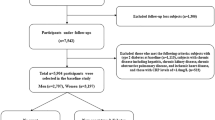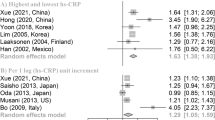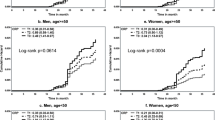Abstract
Aim
The C-reactive protein to albumin (CRP/Alb) ratio has emerged as a novel biomarker for various inflammatory diseases. This study aimed to evaluate the association between the CRP/Alb ratio and incident metabolic syndrome (MetS) with a large-sample, community-based Korean cohort over a 12-year follow-up period.
Materials and methods
Among 10,030 participants, a total of 6205 participants aged 40–69 years without MetS were selected from the Korean Genome and Epidemiology Study (KoGES). The baseline CRP/Alb ratio was divided into quartiles. The definition of newly developed MetS was the one proposed by the 2009 Joint Interim Statement of Circulation. Hazard ratios (HRs) with 95% confidence intervals (CIs) for incident MetS were calculated using multivariable Cox proportional hazards regression models after adjusting for potentially confounding variables.
Results
During the 12-year follow-up period, MetS developed in 2535 subjects (40.9%, 2535/6205) with an incidence rate of 5.6–11.9 (over 2 years). Compared to the reference first quartiles, the HRs (95% CIs) of incident MetS in the second, third, and fourth quartiles increased in a dose-response manner. Compared to the reference quartile, the HRs (95% CIs) of the incidence of MetS for the second, third, and fourth quartiles of CRP/Alb ratio were 1.12 (0.99–1.27), 1.24 (1.11–1.40), and 1.51 (1.34–1.69) after adjusting for age, sex, smoking status, alcohol intake, physical activity, total cholesterol, mean arterial pressure, HOMA-IR, and total energy intake.
Conclusions
High CRP/Alb ratio at baseline may be a useful surrogate indicator of future incident MetS.



Similar content being viewed by others
Data availability
The dataset used in this study (Ansan-Ansung cohort) can be provided after review and evaluation of the research plan by the Korea Disease Control and Prevention Agency (http://www.kdca.go.kr/index.es?sid=a3).
References
E. McCracken, M. Monaghan, S. Sreenivasan, Pathophysiology of the metabolic syndrome. Clin. Dermatol. 36(1), 14–20 (2018)
P.M. Nilsson, J. Tuomilehto, L. Rydén, The metabolic syndrome–What is it and how should it be managed? Eur. J. Prevent. Cardiol. 26(2_suppl), 33–46 (2019)
G. Hirode, R.J. Wong, Trends in the prevalence of metabolic syndrome in the United States, 2011-2016. JAMA 323(24), 2526–2528 (2020)
A.B. Schultz, D.W. Edington, Metabolic syndrome in a workplace: prevalence, co-morbidities, and economic impact. Metab. Syndr. Relat. Disord. 7(5), 459–468 (2009)
A. Lopez-Candales, et al., Linking chronic inflammation with cardiovascular disease: from normal aging to the metabolic syndrome. J. Nat. Sci. 3(4) e341 (2017)
S.K. Masenga et al. Mechanisms of oxidative stress in metabolic syndrome. Int. J. Mol. Sci. 24(9), 7898 (2023)
M. Fröhlich et al. Association between C-reactive protein and features of the metabolic syndrome: a population-based study. Diab. Care 23(12), 1835–1839 (2000)
Y. Song et al. Association between C-reactive protein and metabolic syndrome in Korean adults. Korean J. Fam. Med. 40(2), 116 (2019)
C.J. Wiedermann, Hypoalbuminemia as surrogate and culprit of infections. Int. J. Mol. Sci. 22(9), 4496 (2021)
A. Eckart et al. Relationship of nutritional status, inflammation, and serum albumin levels during acute illness: a prospective study. Am. J. Med. 133(6), 713–722. e7 (2020)
H.M. Cho et al. The association between serum albumin levels and metabolic syndrome in a rural population of Korea. J. Prevent. Med. Public Health 45(2), 98 (2012)
N. Ishizaka et al. Association between serum albumin, carotid atherosclerosis, and metabolic syndrome in Japanese individuals. Atherosclerosis 193(2), 373–379 (2007)
S.-M. ** et al. Change in serum albumin concentration is inversely and independently associated with risk of incident metabolic syndrome. Metabolism 65(11), 1629–1635 (2016)
M. Ishizuka et al. Clinical significance of the C-reactive protein to albumin ratio for survival after surgery for colorectal cancer. Ann. Surg. Oncol. 23, 900–907 (2016)
T.K. Oh, I.-A. Song, J.H. Lee, Clinical usefulness of C-reactive protein to albumin ratio in predicting 30-day mortality in critically ill patients: A retrospective analysis. Sci. Rep. 8(1), 14977 (2018)
G. Qin et al. Serum albumin and C-reactive protein/albumin ratio are useful biomarkers of Crohn’s disease activity. Med. Sci. Monit. 22, 4393–4400 (2016)
I. Sunar, Ş. Ataman, Serum C-Reactive Protein/Albumin ratio in rheumatoid arthritis and its relationship with disease activity, physical function, and quality of life. Arch. Rheumatol. 35(2), 247 (2020)
S. Kalyan et al. Assessing C reactive protein/albumin ratio as a new biomarker for polycystic ovary syndrome: a case–control study of women from Bahraini medical clinics. BMJ Open 8(10), e021860 (2018)
Y. Kim, B.-G. Han; K. Group, Cohort profile: the Korean genome and epidemiology study (KoGES) consortium. Int. J. Epidemiol. 46(2), e20–e20 (2017)
K.G. Alberti et al. Harmonizing the metabolic syndrome: a joint interim statement of the international diabetes federation task force on epidemiology and prevention; national heart, lung, and blood institute; American heart association; world heart federation; international atherosclerosis society; and international association for the study of obesity. Circulation 120(16), 1640–1645 (2009)
A.-R. Cho et al. C-reactive protein-to-albumin ratio and 8‐year incidence of type 2 diabetes: the Korean genome and epidemiology study. Acta Diabetologica 58(11), 1525–1532 (2021)
Y. Karabağ et al. Relationship between C‐reactive protein/albumin ratio and coronary artery disease severity in patients with stable angina pectoris. J. Clin. Lab. Anal. 32(7), e22457 (2018)
A. Sheinenzon et al. Serum albumin levels and inflammation. Int. J. Biol. Macromolecules 184, 857–862 (2021)
D.A. Belinskaia et al. Serum albumin in health and disease: esterase, antioxidant, transporting and signaling properties. Int. J. Mol. Sci. 22(19), 10318 (2021)
Acknowledgements
The authors would like to thank the participants and survey staff of the Korean Genome and Epidemiology Study (KoGES) for their contributions to the present study.
Author contribution
All authors contributed to the study conception and design. Material preparation, data collection and analysis were performed by [Taekyong Lim] and [Yong-Jae Lee]. The first draft of the manuscript was written by [Taekyeong Lim], and all authors commented on previous versions of the manuscript. All authors read and approved the final manuscript.
Funding
This work was supported by the National Research Foundation (NRF) grant funded by the Ministry of Science and ICT of Korea [grant number: NRF-2022R1A2C1013106]. The sponsors had no role in the conceptualization and design of the study, collection and analysis of data, or writing of the article.
Author information
Authors and Affiliations
Corresponding author
Ethics declarations
Conflict of interest
The authors declare no competing interests.
Additional information
Publisher’s note Springer Nature remains neutral with regard to jurisdictional claims in published maps and institutional affiliations.
Rights and permissions
Springer Nature or its licensor (e.g. a society or other partner) holds exclusive rights to this article under a publishing agreement with the author(s) or other rightsholder(s); author self-archiving of the accepted manuscript version of this article is solely governed by the terms of such publishing agreement and applicable law.
About this article
Cite this article
Lim, T., Lee, YJ. C-reactive protein to albumin ratio and risk of incident metabolic syndrome in community-dwelling adults: longitudinal findings over a 12-year follow-up period. Endocrine (2024). https://doi.org/10.1007/s12020-024-03875-4
Received:
Accepted:
Published:
DOI: https://doi.org/10.1007/s12020-024-03875-4




